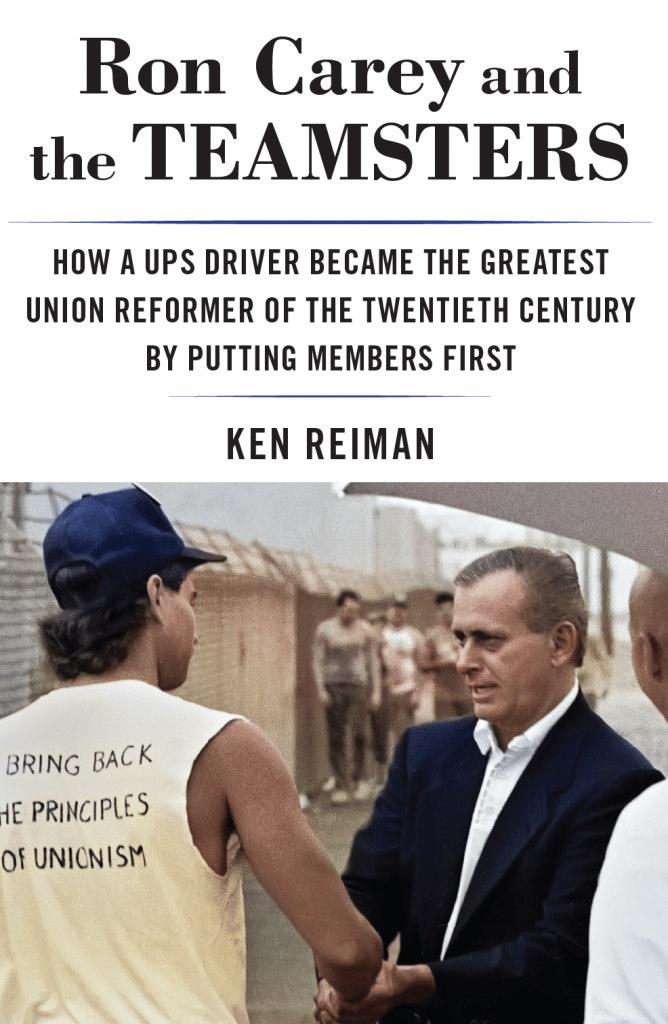JOINT REVIEW: Ron Carey and The Teamsters & Radioactive Radicals

Ron Carey and The Teamsters: How a UPS Driver Became the Greatest Union Reformer of the 20th Century by Ken Reiman, (New York, NY: Monthly Review Press, 2024) and Radioactive Radicals: A Novel of Labor and the Left by Dan La Botz (Trenton, GA: Serge Press, 2024)
Ken Reiman and Dan La Botz are both New York City veterans of the Teamster reform movement, in different eras. They have just published books which draw on their rank-and-file experiences and recall the myriad challenges faced by Ron Carey, the ex-Marine from Queens who battled gangsterism and corruption throughout his career in the International Brotherhood of Teamsters (IBT).
Reiman’s personal connection to the subject matter of Ron Carey and the Teamsters was formed while working for United Parcel Service (UPS) as delivery driver. He became a shop steward, Teamsters for a Democratic Union (TDU) member, and union newsletter editor in IBT Local 804, Carey’s home local.
Books about high-profile labor leaders are usually penned by professional writers — either academic historians, labor journalists, or paid flacks. Past accounts of the life and work of John L. Lewis, Walter Reuther, Jimmy Hoffa, Harry Bridges, or Cesar Chavez have run the gamut from hagiographic to constructively critical.
Few have had a biographer whose view of their leadership role is rooted in actual experience as a blue-collar worker in the same industry and union. Reiman’s insights into the workplace culture and organizational politics of the Teamsters– before, during, and after Carey’s presidency, in the 1990s–provide a unique perspective on the challenges of reform leadership and institutional change in any major union.
 A roman à clef
A roman à clef
Nearly fifty years ago, Dan La Botz was a member of the International Socialists (IS), a truck driver in Chicago and a founding member of TDU. In 1991, he wrote Rank-and-File Rebellion, a semi-official history of TDU’s first several decades, published by Verso. That same year, the always prolific author also produced a Labor Notes best-seller called A Troublemaker’s Handbook: How to Fight Back Where You Work and Win.
A copy of that book ended up in the hands of a then-unknown but already religiously inspired UAW activist in Indiana named Shawn Fain. At a Labor Notes conference attended by 4,000-fired up rank-and-file activists in Chicago last April, Fain held up his tattered copy and declared that it was his “other Bible.” Labor book endorsements by recently elected national union presidents don’t get much better (or more believable) than that.
La Botz’s latest work is a roman à clef. Weighing in at 735-pages, Radioactive Radicals is definitely not as accessible as the first (or more recent edition) of A Troublemaker’s Handbook. It reminded this speed-reader of Going Away, Clancy Sigal’s similarly autobiographical account of a young radical’s migration from campus activism in California to workplace organizing in the industrial mid-west, during the late 1940s and early 50s.
A generation later, La Botz’s own career trajectory was similar. (He also ending up doing teaching and writing, although not in Hollywood, like Sigal, and without becoming a character, so far, in someone else’s roman à clef.). In Radioactive Radicals, La Botz describes, in sometimes painful personal detail, the not-always-helpful influence of often competing left sects which encouraged Sixties’ radicals to transition from campus activism to workplace agitation in the Teamsters, Steel Workers, United Auto Workers, and other unions.
La Botz’s fictional account of his own experience as a left-wing “colonizer” will be of great interest to younger radicals toiling today at Amazon, Starbucks, Google, or Microsoft. All of these brand name firms have been the focus of union-building efforts, by self-organized groups and/or existing unions like the Teamsters, Workers United, or Communications Workers of America. Now, as in the past, interaction between shop floor socialists, their less “political” co-workers, labor union bureaucracies, and big companies still fighting unionization (or finally coming to terms with it) can be tense and complex. (One key to successful organizing is not becoming too “radioactive” in your own workplace!)
Scandal Driven Democracy
Reiman’s well-researched and detailed account of Ron Carey’s rise and fall—and La Botz’s fictional rendering of the same tragic events —contain valuable lessons and insights for Teamsters and other union members. Let’s hope that there is an equally talented UAW local union newsletter editor, working in a factory today or in higher education, who similarly aspires to be Shawn Fain’s biographer (or an historian of Unite All Workers for Democracy (UAWD), the TDU-inspired opposition caucus that backed him for UAW president on a broader reform slate two years ago).
After leading a newly mobilized membership in a successful selective strike in the auto industry last year, Fain is now skirmishing with a court-appointed overseer of Solidarity House, over multiple issues. The latter owes his position to the corruption scandals that led to adoption of direct (rather than convention) election of the union’s top officials. In Carey’s case, the referendum election system imposed on the IBT, under the terms of a federal racketeering case settlement in 1989, also enabled him and other TDU-backed candidates to win top leadership roles.
As Reiman reports, the union’s reform faction then faced continuing resistance from well entrenched internal foes. Carey’s crackdown on crooks and leadership perks alienated large sections of the Teamster officialdom. In 1996, the still-powerful local officialdom, which backed two competing “Old Guard” candidates five years earlier, bankrolled a unified $4 million challenge to Carey. It was fronted by a local union lawyer with the most famous last name in Teamsterdom.
James Hoffa, who ended up serving as IBT president for several strike-free decades, masqueraded successfully as a populist critic of a “New Teamster” regime dominated by “outsiders.” Meanwhile, as Reiman documents, some of Carey’s re-election campaign fund-raisers and helpers, hired from outside the union, engaged in criminal misconduct of their own.
This dealt a huge self-inflicted blow to the moral authority and public reputation of Carey’s administration, leading to his removal from office, lifetime ban from the union, and prosecution for perjury (He was acquitted in 2001.)
While these dark legal and political clouds were gathering in 1997, Carey led 185,000 of his fellow UPS workers in the biggest nationwide strike in the last 30 years. The UPS contract campaign, preceding that walk-out, employed membership education and mobilization, labor-community coalition building, and media outreach that the union had never utilized before.
As Ken Reiman shows, that landmark struggle, widely hailed at the time and still fondly remembered today, would not have been possible without a Teamsters president who believed in rank-and-file power—and wasn’t afraid to use it.
Reviewed by Steve Early, who worked with the Teamster reform movement in the late 1970s, before becoming a Boston-based CWA Organizer and International Representative in the northeast for three decades. He is still active in the NewsGuild/CWA and has written five books about labor, politics, or veterans affairs. He can be reached at Lsupport@aol.com.

UAW President Shawn Fain held up a dog-eared copy of a Labor Notes classic, A Troublemaker’s Handbook, in his closing speech at the 2024 Conference. Photo: Jim West/jimwestphoto.com
